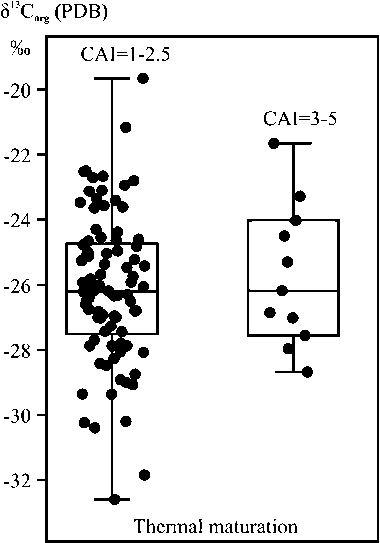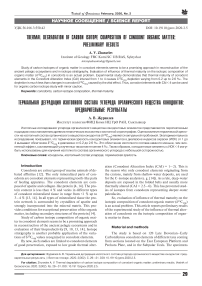Thermal degradation of carbon isotope composition of conodont organic matter: preliminary results
Автор: Zhuravlev A.V.
Журнал: Вестник геонаук @vestnik-geo
Рубрика: Научные статьи
Статья в выпуске: 2 (302), 2020 года.
Бесплатный доступ
Study of carbon isotopes of organic matter in conodont elements seems to be a promising approach in reconstruction of the ancient pelagic ecosystems and in isotope stratigraphy. Evaluation of influence of thermal maturity on the isotopic composition of organic matter (d13Corg) in conodonts is an actual problem. Experimental study demonstrates that thermal maturity of conodont elements in the Conodont Alteration Index (CAI) interval from 1 to 4 causes d13Corg depletion varying from 0.2 up to 2.6 ‰. The depletion is much less than changes in conodont d13Corg caused by the vital effect. Thus, conodont elements with CAI
Conodonts, carbon isotope composition, thermal maturity
Короткий адрес: https://sciup.org/149129417
IDR: 149129417 | УДК: 56.016.3:550.42 | DOI: 10.19110/geov.2020.2.5
Текст краткого сообщения Thermal degradation of carbon isotope composition of conodont organic matter: preliminary results
Conodonts are extinct group of marine animals of debated affinities [12]. The only mineralized parts of conodonts are conodont elements representing tooth-like parts of feeding apparatus. The conodont elements are composed of apatite and collagen-like protein [4, 14]. The protein content is less than 4 % and varies in different types of conodont mineralized tissue in range from <1 % up to 3—4 % [13, 14]. In all types of mineralized tissue the protein network is surrounded by crystallites of apatite and strongly incorporated into the mineral matrix. This provides conditions for exceptional preservation of the organic matter, including secondary structures of the protein [14].
Study of carbon isotope composition of organic matter in conodont elements seems to be a promising approach in reconstruction of the ancient pelagic ecosystems and in evaluation of their bioproductivity [9, 10, 13, 14]. Isotope stratigraphy is another probable application of the variations of δ13Corg values recognized in conodont elements.
By now, such studies are limited to conodont elements of good preservation, exposed to low grade thermal alter- ation (Conodont Alteration Index (CAI) = 1—2). This is the reason why only conodont elements originating from the cratons, mainly from shallow-water deposits, are used for the C-isotope analysis (e. g. [14]). As a rule, deep-water deposits are exposed in the folded belts and usually more thermally altered (CAI = 2.5—6). This has prevented studies of isotopes from conodonts representing deeper-water paleofacies.
So, evaluation of influence of thermal maturity on the isotopic composition of conodont organic matter (δ13Corg) is an actual problem. This article reports preliminary results of the experimental study of the influence of thermal alteration of conodonts on the isotopic composition of organic matter in them.
Material and methods
The study is based on 120 Late Devonian–Early Carboniferous conodont elements of different taxa coming from sections located on the East European Platform and Pechora Plate, and in the Subpolar Urals. The specimens

Distribution of 813Corg values in conodont elements of different thermal maturation. Conodont Alteration Index (CAI) is used as thermal maturation proxy. To show overlapping points more clearly, they are horizontally displaced using a random value (not in CAI scale). The 25—75 percent quartiles are drawn using a box. The median is shown with a horizontal line inside the box. The minimal and maximal values are shown with short horizontal lines Распределение значений 813Corg конодонтовых элементов различной термической зрелости. В качестве показателя термической зрелости используются индексы окраски конодонтов (CAI). Чтобы показать перекрывающиеся точки, они смещены произвольным образом по горизонтали (смещение не отвечает вариациям CAI). Прямоугольник соответствует квартилям 25—75 %. Горизонтальная линия внутри прямоугольника отмечает медианное значение. Минимальное и максимальное значения отмечены короткими горизонтальными рисками represent various degree of thermal maturity (CAI from 1 to 5). Main part of the information related to this database was published earlier [13, 14].
Four conodont elements were used for experimental study. They were broken in two nearly equal fragments using a steel needle. One fragment of each element was heated during 60—90 min at T = 600 °C in dry microenvironment, which resulted in CAI = 3.5—4 [3]. Another one was kept unchanged (CAI = 1). Carbon isotope composition was studied from both fragments (Table 1).
Carbon isotope composition was analyzed with the DELTA V Advantage mass spectrometer equipped with the Thermo Electron Continuous Flow Interface (ConFlo III) and Element Analyzer (Flash EA 1112) (Geonauka CCU of the Institute of Geology Komi SC UrB RAS, Syktyvkar, Russia). The 813Corg values are reported relative to the PDB standard with precision ±0.15 %o. Detailed description of the methods was published earlier [13, 14].
Results and discussion
Main factors affecting the carbon isotope composition of conodont organic matter are supposed to be as follows:
-
1. Vital effect of the organism including the isotope composition of the carbon source; isotope effects associated with the assimilation of carbon; isotope effects related to metabolism and biosynthesis [2, 5, 13, 14].
-
2. Secondary changes including microbiological, epigenetic, and thermal degradation of the conodont organic matter [8, 13, 14].
Cumulative vital effect can be evaluated as difference between maximum and minimum 813Corg values in unaltered (CAI = 1) conodont elements of a species (A813Corg). Another measure of the amount of 813Corg variation is double standard deviation (2o 813Corg). P1 elements of conodonts belonging to 7 different species, namely Hindeodus crassidentatus (Branson et Mehl), Icriodus cornutus Sannemann, Jablonnodus erectus Dzik, Mehlina gradata Youngquist, Mesotaxis asymmetricus (Bischoff et Ziegler),
Table 1. Vital effect in 8 13Corg in Late Devonian — Early Carboniferous conodonts. See explanations in the text Таблица 1. Жизненный эффект в 13Copгy позднедевонско-раннекаменноугольных конодонтов (объяснения в тексте)
|
Taxon |
Number of specimens |
min 813Corg (%) |
max 813Corg (%) |
A8 i3 C org (%) |
2a 813C org (%) |
|
Hindeodus crassidentatus |
5 |
-29.0 |
-23.3 |
5.7 |
4.3 |
|
Icriodus cornutus |
3 |
-27.9 |
-23.1 |
4.8 |
4.9 |
|
Jablonnodus erectus |
4 |
-28.1 |
-23.1 |
5.0 |
4.2 |
|
Mehlina gradata |
4 |
-31.9 |
-24.7 |
7.2 |
6.4 |
|
Mesotaxis asymmetricus |
6 |
-27.0 |
-22.4 |
4.6 |
3.6 |
|
Polygnathus communis communis |
18 |
-32.6 |
-24.1 |
8.5 |
4.2 |
|
Polygnathus parapetus |
31 |
-30.4 |
-22.5 |
7.9 |
4.3 |
Table 2. Experimental thermal changes in 8 13Corg values in conodont elements
Таблица 2. Экспериментальное термальное изменение значений 8 13Copг конодонтовых элементов
|
Conodont element |
T (°C) |
Time (min) |
Initial 813Corg (%) (CAI = 1) |
813CO r g (%) after heating |
813Corg change (%) |
CAI after heating |
|
M-element |
600 |
90 |
-24.31 |
-26.86 |
-2.55 |
4 |
|
Mesotaxis bogoslovski |
600 |
90 |
-27.03 |
-27.56 |
-0.53 |
4 |
|
Mehlina gradata |
600 |
60 |
-26.81 |
-27.02 |
-0.21 |
3.5 |
|
S-element |
600 |
60 |
-27.4 |
-28.68 |
-1.28 |
3.5 |
Polygnathus communis communis Branson et Mehl, and Polygnathus parapetus Druce, were used for this evaluation. Table 1 demonstrates that ∆δ13Corg varies from 4.6 ‰ up to 8.5 ‰; but statistically significant ∆δ13Corg values, derived from more than 10 measurements, are about 8—8.5 ‰ ( Polygnathus communis communis Branson et Mehl and Polygnathus parapetus Druce respectively). Double standard deviation of δ13Corg in conodont elements of single species ranges from 3.6 ‰ to 6.4 ‰ (Table 1). Thus we can suppose that vital effect can be higher than 3.6‰ in any case.
Existing data on thermal degradation of bioapatite and collagen-like proteins allow us to predict changes in conodont elements during heating. Recrystallization of the bioapatite starts at 300 °C [6]. Long-time heating at this temperature results in CAI = 5 [3]. Thus, changes in mineral component of conodont elements can be expected at CAI > 5. Recrystallization of conodont bioapatite leads to the destruction of organic matrix in any case. Collagen thermal denaturation starts at 60—65 °C in hydrated condition and at 150 °C in dry environment [1], that promises good preservation of organic components at CAI < 3 (corresponds to T < 150 °C).
In general, isotopic composition of organic matter in sedimentary rocks demonstrates unclear dependences from the thermal maturity. For example, McKirdy and Powell [7] noted that unaltered organic matter is isotopically lighter than metamorphosed material, and post-depositional thermal alteration may lead to positive shift in carbon isotope composition. In contrast, no significant correlation between thermal alteration and δ13Corg is apparent from data by Strauss and Peters-Kottig [11].
Study of carbon isotope composition of organic matter in conodont elements of various degree of thermal maturity (CAI) demonstrates insignificant differences in mean values of δ13Corg (Fig. 1). However, in this case the vital effect is not accounted. Experimental data, which allow avoiding the vital effect, demonstrate that heating up to CAI = 4 leads to negative shift in carbon isotope composition of conodont organic matter (Table 2). This shift ranges from 0.2 to 2.6 ‰. It is notable that the observed thermal shift of δ13Corg value is much less than the cumulative vital effect.
Conclusions
Thermal maturity of conodont elements in range of CAI from 1 to 4 causes δ13Corg depletion varying between 0.2 and 2.6 ‰. Vital effect is much higher than the effect of thermal degradation recorded. Thus, conodont elements with CAI < 4 can be used for organic carbon isotope study with minor caution. However, differences in the conodont δ13Corg values less than 3 ‰ may be caused by variations in their thermal maturity. This possibility allows using the conodont carbon isotope data for any pa-leoecological and stratigraphic purposes with minor cautions.
Acknowledgements. The author is greatly appreciated to I. V. Smoleva for assistance in isotope studies.
Список литературы Thermal degradation of carbon isotope composition of conodont organic matter: preliminary results
- Bozec, L., Odlyha M. Thermal Denaturation Studies of Collagen by Microthermal Analysis and Atomic Force Microscopy. Biophysical Journal, 2011, pp. 228-236.
- DeNiro M. J., Schoeninger M. J. Stable carbon and nitrogen isotope ratios of bone collagen: variations within individuals, between sexes, and within populations raised on monotonous diets. J. Archaeol. Sci., 1983, 10(3), pp. 199-203.
- Epstein A. G., Epstein J. B., & Harris L. D. Conodont Color Alteration - an Index Organic Metamorphism. U. S. Geological Survey Professional Paper, 1977, 995, pp. 1-27.
- Frank-Kamenetskaya O. V., Rozhdestvenskaya I. V., Rosseeva E. V., Zhuravlev A. V. Refinement of Apatite Atomic Structure of Albid Tissue of Late Devon Conodont. Crystallography Reports, 2014, 59(1), pp. 41-47.
- Hayes J. M. Factors controlling 13C contents of sedimentary organic compounds: principles and evidence. Marine Geology, 1993, 113, pp. 111-125.


